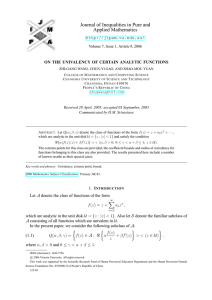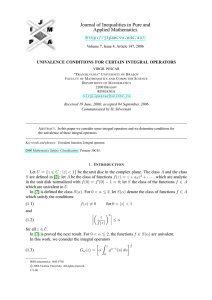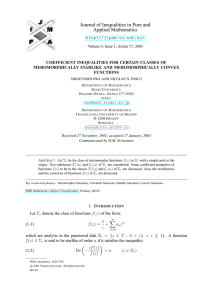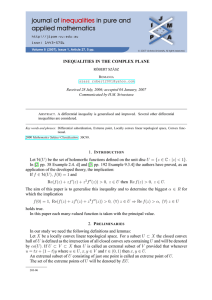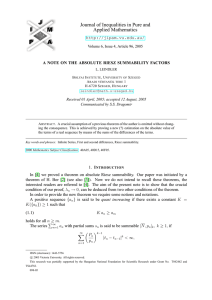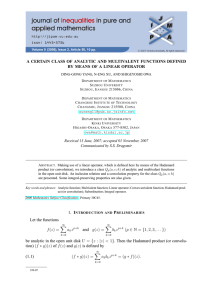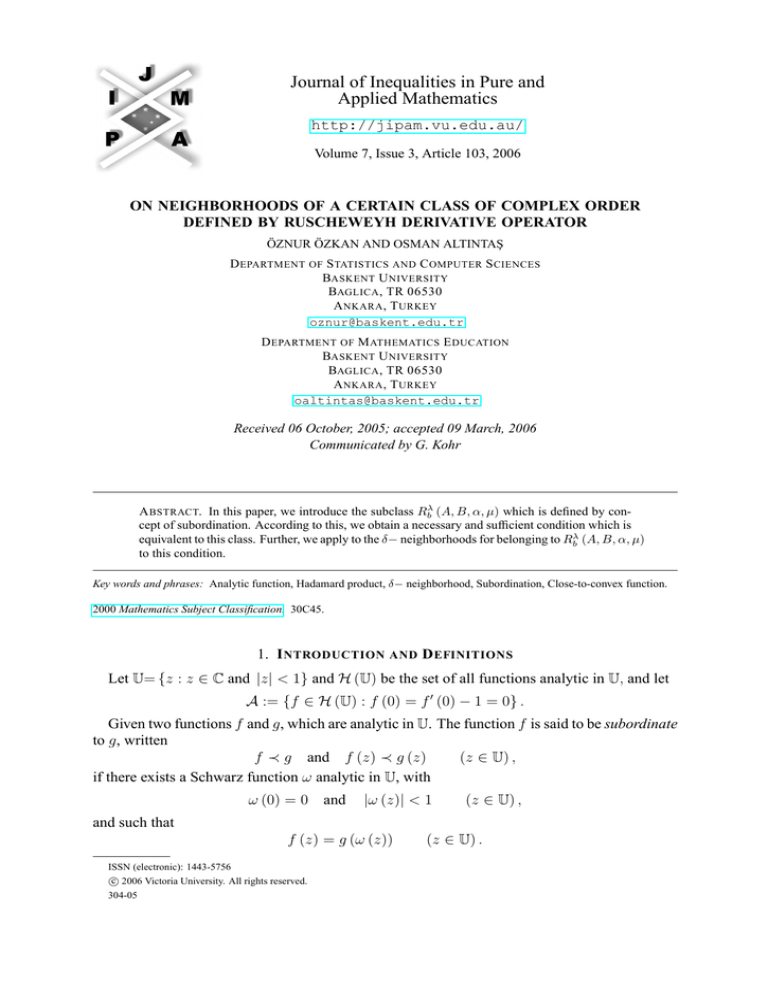
Journal of Inequalities in Pure and
Applied Mathematics
http://jipam.vu.edu.au/
Volume 7, Issue 3, Article 103, 2006
ON NEIGHBORHOODS OF A CERTAIN CLASS OF COMPLEX ORDER
DEFINED BY RUSCHEWEYH DERIVATIVE OPERATOR
ÖZNUR ÖZKAN AND OSMAN ALTINTAŞ
D EPARTMENT OF S TATISTICS AND C OMPUTER S CIENCES
BASKENT U NIVERSITY
BAGLICA , TR 06530
A NKARA , T URKEY
oznur@baskent.edu.tr
D EPARTMENT OF M ATHEMATICS E DUCATION
BASKENT U NIVERSITY
BAGLICA , TR 06530
A NKARA , T URKEY
oaltintas@baskent.edu.tr
Received 06 October, 2005; accepted 09 March, 2006
Communicated by G. Kohr
A BSTRACT. In this paper, we introduce the subclass Rbλ (A, B, α, µ) which is defined by concept of subordination. According to this, we obtain a necessary and sufficient condition which is
equivalent to this class. Further, we apply to the δ− neighborhoods for belonging to Rbλ (A, B, α, µ)
to this condition.
Key words and phrases: Analytic function, Hadamard product, δ− neighborhood, Subordination, Close-to-convex function.
2000 Mathematics Subject Classification. 30C45.
1. I NTRODUCTION AND D EFINITIONS
Let U= {z : z ∈ C and |z| < 1} and H (U) be the set of all functions analytic in U, and let
A := {f ∈ H (U) : f (0) = f 0 (0) − 1 = 0} .
Given two functions f and g, which are analytic in U. The function f is said to be subordinate
to g, written
f ≺ g and f (z) ≺ g (z)
(z ∈ U) ,
if there exists a Schwarz function ω analytic in U, with
ω (0) = 0 and
|ω (z)| < 1
(z ∈ U) ,
and such that
f (z) = g (ω (z))
ISSN (electronic): 1443-5756
c 2006 Victoria University. All rights reserved.
304-05
(z ∈ U) .
2
Ö ZNUR Ö ZKAN AND O SMAN A LTINTA Ş
In particular, if g is univalent in U, then f ≺ g if and only if f (0) = g (0) and f (U) ⊂ g (U)
in [7].
Next, for the functions fj (j = 1, 2) given by
fj (z) = z +
∞
X
ak,j z k
(j = 1, 2) .
k=2
Let f1 ∗ f2 denote the Hadamard product (or convolution) of f1 and f2 , defined by
(f1 ∗ f2 ) (z) := z +
(1.1)
∞
X
ak,1 ak,2 z k =: (f2 ∗ f1 ) (z) .
k=2
(a)v denotes the Pochhammer symbol (or the shifted factorial), since
(1)n = n!
for n ∈ N0 := N ∪ {0} ,
defined (for a, v ∈ C and in terms of the Gamma function) by
(
1;
(v = 0, a ∈ C\ {0}) ,
Γ (a + v)
(a)v :=
=
Γ (a)
a (a + 1) . . . (a + n − 1) ; (v = n ∈ N; a ∈ C) .
The earlier investigations by Goodman [1] and Ruscheweyh [9], we define the δ− neighborhood of a function f ∈ A by
(
∞
X
Nδ (f ) := g ∈ A : f (z) = z +
ak z k ,
k=2
g (z) = z +
∞
X
bk z k
∞
X
and
k=2
)
k |ak − bk | ≤ δ
k=2
so that, obviously,
(
Nδ (e) :=
g ∈ A : g (z) = z +
∞
X
bk z k
and
∞
X
k=2
)
k |bk | ≤ δ
,
k=2
where e (z) := z.
Ruscheweyh [8] introduced an linear operator Dλ : A −→ A, defined by the Hadamard
product as follows:
z
∗ f (z)
(λ > −1; z ∈ U),
Dλ f (z) :=
(1 − z)λ+1
which implies that
(n)
Dn f (z) =
z (z n−1 f (z))
n!
(n ∈ N0 := N∪ {0}).
Clearly, we have
D0 f (z) = f (z) ,
D1 f (z) = zf 0 (z)
and
Dn f (z) =
∞
X
(λ + 1)
k=0
(1)k
k
ak+1 z k+1 =
∞
X
(λ + 1)
k=0
(1)k
!
k k+1
z
∗f
(z) ,
where f ∈ A.
J. Inequal. Pure and Appl. Math., 7(3) Art. 103, 2006
http://jipam.vu.edu.au/
O N N EIGHBORHOODS OF A C ERTAIN C LASS OF C OMPLEX O RDER D EFINED BY RUSCHEWEYH D ERIVATIVE O PERATOR
3
Therefore, we can write the following equality, the easily verified result from the above definitions:
00
0
0
Dλ f (z)
1
λ
λ
λ
(1.2)
(1 − µ)
,
+ µ D f (z) ∗
2 = D f (z) + µz D f (z)
z
(1 − z)
where f ∈ A, λ (λ > −1) , µ (µ ≥ 0) and for all z ∈ U.
For each A and B such that −1 ≤ B < A ≤ 1 and for all real numbers α such that 0 ≤ α < 1,
we define the function
1 + {(1 − α) A + αB} z
h (A, B, α; z) :=
(z ∈ U) .
1 + Bz
Also, let h (α) denote the extremal function of functions with positive real part of order α
(0 ≤ α < 1), defined by
h (α) := h (1, −1, α; z) =
1 + (1 − 2α) z
1−z
(z ∈ U) .
The class Rb (A, B) is studied by Premabai in [3]. According to this, we introduce the
subclass Rλb (A, B, α, µ) which is a generalization of this class, as follows:
i
0
00
1h λ
λ
(1.3)
1+
D f (z) + µz D f (z) − 1 ≺ h (A, B, α; z) ,
b
where f ∈ A, b ∈ C/ {0}, for some real numbers A, B (−1 ≤ B < A ≤ 1) , λ (λ > −1) ,
α (0 ≤ α < 1) , µ (µ ≥ 0) and for all z ∈ U with Rb (A, B, α, µ) := R0b (A, B, α, µ) and
Rb (A, B) := Rb (A, B, 0, 0) .
We note that the class Rb (µ) := Rb (1, −1, 0, µ) is studied by Altıntaş and Özkan in [4].
Therefore C (b) := Rb (1, −1, 0, 0) is the class of close-to-convex functions of complex order b.
C (α) := R1−α (1, −1, 0, 0) is the class of close-to-convex functions of order α (0 ≤ α < 1).
Also, let Tb (A, B, α) denote the class of functions φ normalized by
n
o
it
1
1 + 1b (1−z)
−
1
− 1+{(1−α)A+αB}e
2
1+Beit
(1.4)
φ (z) :=
(t ∈ (0, 2π)) ,
it
1 − 1+{(1−α)A+αB}e
it
1+Be
where b ∈ C/ {0} , for some real numbers A, B (−1 ≤ B < A ≤ 1) , for all α (0 ≤ α < 1) and
for all z ∈ U with Tb (A, B) := Tb (A, B, 0) and T (b) := Tb (1, −1, 0) .
2. T HE M AIN R ESULTS
A theorem that contains the relationship between the above classes is given as follows:
Theorem 2.1. f ∈ Rλb (A, B, α, µ) if and only if
0
Dλ f (z)
λ
(1 − µ)
+ µ D f (z) ∗ φ (z) 6= 0
z
for all φ ∈ Tb (A, B, α) and for all f ∈ A.
Proof. Firstly, let
zλ (f, µ; z) := (1 − µ)
0
Dλ f (z)
+ µ Dλ f (z)
z
and we suppose that
(2.1)
zλ (f, µ; z) ∗ φ (z) 6= 0
J. Inequal. Pure and Appl. Math., 7(3) Art. 103, 2006
http://jipam.vu.edu.au/
4
Ö ZNUR Ö ZKAN AND O SMAN A LTINTA Ş
for all f ∈ A and for all φ ∈ Tb (A, B, α) . In view of (1.4) , we have
n
o
it
1
1 + 1b zλ (f, µ; z) ∗ (1−z)
−
1
− 1+{(1−α)A+αB}e
2
it
1+Be
zλ (f, µ; z) ∗ φ (z) =
it
1 − 1+{(1−α)A+αB}e
1+Beit
n
o
0
00
it
1
λ
λ
1 + b D f (z) + µz D f (z) − 1 − 1+{(1−α)A+αB}e
1+Beit
=
it
1 − 1+{(1−α)A+αB}e
1+Beit
6= 0.
From this inequality we find that
o
0
00
1n λ
λ
1+
D f (z) + µz D f (z) − 1 6= h A, B, α; eit ,
b
where t ∈ (0, 2π) .
n
o
0
00
This means that 1+ 1b Dλ f (z) + µz Dλ f (z) − 1 does not take any value on the image ofn under h (A, B, α; z) function o
of the boundary of U. Therefore we note that
0
00
1
λ
λ
1 + b D f (z) + µz D f (z) − 1 takes the value 1 for z = 0. Since 0 ≤ α < 1
and B < A, 1 is contained by the image under h (A, B, α; z) function of U.Thus, we can write
o
0
00
1n λ
1+
D f (z) + µz Dλ f (z) − 1 ≺ h (A, B, α; z) .
b
λ
Hence f ∈ Rb (A, B, α, µ) .
Conversely, assume the function f is in the class Rλb (A, B, α, µ) . From the definition of
subordination, we can write the following inequality:
o
0
00
1n λ
1+
D f (z) + µz Dλ f (z) − 1 6= h A, B, α; eit ,
b
where t ∈ (0, 2π) . From (1.2) we can write
1
1
λ
1+
z (f, µ; z) ∗
6= h A, B, α; eit
2 −1
b
(1 − z)
or equivalently,
zλ (f, µ; z) ∗
1 + 1b
1
(1−z)2
− 1 − h (A, B, α; eit )
1 − h (A, B, α; eit )
.
Thus, from the definition of the function φ, we can write
0
Dλ f (z)
λ
(1 − µ)
+ µ D f (z) ∗ φ (z) 6= 0
z
for all φ ∈ Tb (A, B, α) and for all f ∈ A.
h
Corollary 2.2. f ∈ Rb (A, B, α, µ) if and only if (1 − µ) f (z)
z
φ ∈ Tb (A, B, α) and for all f ∈ A.
Proof. By putting λ = 0 in Theorem 2.1.
Corollary 2.3. f ∈ Rb (A, B) if and only if
f ∈ A.
J. Inequal. Pure and Appl. Math., 7(3) Art. 103, 2006
i
+ µf 0 (z) ∗ φ (z) 6= 0 for all
f (z)
z
∗ φ (z) 6= 0 for all φ ∈ Tb (A, B) and for all
http://jipam.vu.edu.au/
O N N EIGHBORHOODS OF A C ERTAIN C LASS OF C OMPLEX O RDER D EFINED BY RUSCHEWEYH D ERIVATIVE O PERATOR
5
Proof. By putting α = 0, µ = 0 in Corollary 2.2. And, we obtain the result of Theorem 1 in
[3].
f (z)
z
Corollary 2.4. f ∈ C (b) if and only if
∗ φ (z) 6= 0 for all φ ∈ T (b) and for all f ∈ A.
Proof. By putting A = 1, B = −1 in Corollary 2.3.
Theorem 2.5. Let z (z) = f (z)+z
for ∈ C and f ∈ A. If z ∈ Rλb (A, B, α, µ) for || < δ ∗ ,
1+
then
λ
0
D
f
(z)
λ
(1 − µ)
≥ δ∗
(2.2)
+
µ
D
f
(z)
∗
φ
(z)
(z ∈ U) ,
z
where φ ∈ Tb (A, B, α) and for all f ∈ A.
Proof. Let φ ∈ Tb (A, B, α) and z ∈ Rλb (A, B, α, µ) . From Theorem 2.1, we can write
0
Dλ z (z)
λ
+ µ D z (z) ∗ φ (z) 6= 0.
(1 − µ)
z
Using Dλ (z) = z, we find that the following inequality
0
1
Dλ f (z)
λ
(1 − µ)
+ µ D f (z) ∗ φ (z) + 6= 0
1+
z
that is,
0
Dλ f (z)
λ
(1 − µ)
+ µ D f (z) ∗ φ (z) 6= −
z
or equivalently (2.2) .
Lemma 2.6. If φ (z) = 1 +
P∞
k=1 ck z
k
∈ Tb (A, B, α), then we have
(k + 1) (1 + |B|)
(k = 1, 2, 3, . . .) .
(1 − α) |b| |B − A|
P
k
Proof. We suppose that φ (z) = 1 + ∞
k=1 ck z ∈ Tb (A, B, α) . From (1.4) , we have
P
it
∞
k−1
X
1 + 1b 1 + ∞
− 1 − 1+{(1−α)A+αB}e
k=2 kz
1+Beit
k
1+
ck z =
(t ∈ (0, 2π)) .
1+{(1−α)A+αB}eit
1
−
k=1
1+Beit
(2.3)
|ck | ≤
We write the following equality result which is easily verified result from the above equality:
ck =
(k + 1) (1 + Beit )
.
.
b (1 − α) (B − A) eit
Taking the modulus of both sides, we obtain inequality (2.3) .
Theorem 2.7. If z ∈ Rλb (A, B, α, µ) for || < δ ∗ , then
Nδ (f ) ⊂ Rλb (A, B, α, µ) ,
where δ :=
(1−α)|b||B−A|
δ∗.
(1+λ)(1+µ)(1+|B|)
Proof. Let g ∈ Nδ (f ) for δ =
If we take
(1−α)|b||B−A|
δ∗.
(1+λ)(1+µ)(1+|B|)
zλ (g, µ; z) := (1 − µ)
J. Inequal. Pure and Appl. Math., 7(3) Art. 103, 2006
0
Dλ g (z)
+ µ Dλ g (z) ,
z
http://jipam.vu.edu.au/
6
Ö ZNUR Ö ZKAN AND O SMAN A LTINTA Ş
then
λ
z (g, µ; z) ∗ φ (z)
0
Dλ (f + g − f ) (z)
λ
= (1 − µ)
+ µ D (f + g − f ) (z) ∗ φ (z)
z
λ
≥ z (f, µ; z) ∗ φ (z) − zλ (g − f, µ; z) ∗ φ (z)
and using Theorem 2.5 we can write
∞
X
(2.4)
≥ δ∗ − Ψ (k) (bk − ak ) ck−1 z k−1 ,
k=2
where
Ψ (k) =
(λ + 1)(k−1)
(1)k
(µk − µ + 1) .
We know that Ψ (k) is an increasing function of k and
0 < Ψ (2) = (1 + λ) (1 + µ) ≤ Ψ (k)
µ ≥ 0; k ∈ N; λ ≥
−µk
(1 + µk)
.
Since z ∈ Rλb (A, B, α, µ) for || < δ ∗ and using Lemma 2.6 in (2.4) we have
∞
X
λ
z (g, µ; z) ∗ φ (z) > δ ∗ − Ψ (2) |z|
|ak − bk |
k=2
k (1 + |B|)
(1 − α) |b| |B − A|
∞
(1 + λ) (1 + µ) (1 + |B|) X
k |ak − bk |
>δ −
(1 − α) |b| |B − A|
k=2
∗
> δ∗ − δ
(1 + λ) (1 + µ) (1 + |B|)
(1 − α) |b| |B − A|
> 0.
That is, we can write
0
Dλ g (z)
λ
(1 − µ)
+ µ D g (z) ∗ φ (z) 6= 0
z
Thus, from Theorem 2.1 we can find that g ∈ Rλb (A, B, α, µ) .
(z ∈ U) .
Corollary 2.8. If z ∈ Rb (A, B, α, µ) for || < δ ∗ , then
Nδ (f ) ⊂ Rb (A, B, α, µ) ,
where δ :=
(1−α)|b||B−A| ∗
δ .
(1+µ)(1+|B|)
Proof. By putting λ = 0 in Theorem 2.7.
Corollary 2.9. If z ∈ Rb (A, B) for || < δ ∗ , then
Nδ (f ) ⊂ Rb (A, B)
where δ :=
|b||B−A| ∗
δ .
(1+|B|)
Proof. By putting α = 0, µ = 0 in Corollary 2.8. Thus, we obtain the result of Theorem 2.7 in
[3].
J. Inequal. Pure and Appl. Math., 7(3) Art. 103, 2006
http://jipam.vu.edu.au/
O N N EIGHBORHOODS OF A C ERTAIN C LASS OF C OMPLEX O RDER D EFINED BY RUSCHEWEYH D ERIVATIVE O PERATOR
7
Corollary 2.10. If z ∈ C (b) for || < δ ∗ , then
Nδ (f ) ⊂ C (b) ,
∗
where δ := |b| δ .
Proof. By putting A = 1, B = −1 in Corollary 2.9.
R EFERENCES
[1] A.W. GOODMAN, Univalent functions and non analytic curves, Proc. Amer. Math. Soc., 8 (1957),
598–601.
[2] K.K. DIXIT AND S.K. PAL, On some class of univalent functions related to complex order, Indian
J. Pure and Appl. Math., 26(9) (1995), 889–896.
[3] M. PREMABAI, On the neighborhoods of a subclass of univalent functions related to complex order,
South. Asian Bull. Math., 26 (2002), 71–75.
[4] O. ALTINTAŞ AND Ö. ÖZKAN, Starlike, convex and close-to-convex functions of complex order,
Hacettepe Bull. of Natur.Sci. and Eng., 28 (1999), 37–46.
[5] O. ALTINTAŞ, Ö. ÖZKAN AND H.M. SRIVASTAVA, Neighborhoods of a class of analytic functions with negative coefficients, App. Math. Lett., 13(3) (2000), 63–67.
[6] O. ALTINTAŞ, Ö. ÖZKAN AND H.M. SRIVASTAVA, Neighborhoods of a certain family of multivalent functions with negative coefficients, Comp. Math. Appl., 47 (2004), 1667–1672.
[7] S.S. MILLER AND P.T. MOCANU, Differential Subordinations: Theory and Applications, Series
on Monographs and Textbooks in Pure and Applied Mathematics, Vol. 225, Marcel Dekker, New
York, (2000).
[8] St. RUSCHEWEYH, New criteria for univalent fınctions, Proc. Amer. Math. Soc., 49 (1975), 109–
115.
[9] St. RUSCHEWEYH, Neighborhoods of univalent functions, Proc. Amer. Soc., 81 (1981), 521–527.
J. Inequal. Pure and Appl. Math., 7(3) Art. 103, 2006
http://jipam.vu.edu.au/


